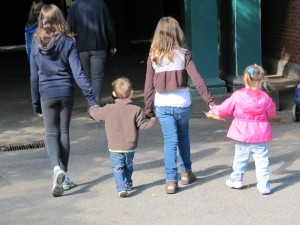 Why do some kids grow up in two-parent homes with all the apparent support and advantages a child could need, yet still end up making poor choices that lead them to problems with drugs, alcohol or other high-risk behaviors? Conversely, why do some kids come from broken homes, dysfunctional families or communities dealing with alcohol and drugs, and yet are still able to resist the pull of these activities?
Why do some kids grow up in two-parent homes with all the apparent support and advantages a child could need, yet still end up making poor choices that lead them to problems with drugs, alcohol or other high-risk behaviors? Conversely, why do some kids come from broken homes, dysfunctional families or communities dealing with alcohol and drugs, and yet are still able to resist the pull of these activities?
While each individual case may be different, experts often point to the complex notion of resilience to explain the qualities that enable some kids to navigate safely through the pitfalls of high-risk activities, while others seem to inexplicably fall through the cracks.
When I teach workshops about risk prevention, I always make a point of covering what the American Academy of Pediatrics calls the “The 7 C’s of Resilience.” These seven points (competence, confidence, connection, character, control, coping and contribution) cover the key elements that kids need to deal with the challenges that life throws their way.
Knowing these qualities are part of resilience is only part of the battle; the key question is how to build on them so each child is best positioned to make healthy choices for themselves during their teen years and into adulthood. In my workshops, I focus in on specific strategies parents and teachers can use at different ages to build these qualities with kids. Ideally, building resilience is something we want to begin when kids are very young, but it’s never too late to start.
But while all of them are important, the academic literature on resilience is particularly emphatic about the importance of good coping strategies. Coping strategies make the difference between a kid who crumples in tears at the first sign of adversity and the child who is able to deal with the stress and figure out how to move forward to some kind of resolution.
It’s what all parents hope our kids can do. But that isn’t always the case.
As a university professor, I occasionally met kids with poor coping skills. Many of these kids don’t even make it to college, but often enough mom or dad hovered in the background waiting to pick up the pieces and help make everything OK. But parents don’t come to university classes, and they don’t micromanage their grown up children’s class schedules the way they might have in high school.
So when someone fails a test, or hands in an assignment late without any good excuse, or misses some important administrative deadline, the students with poor coping skills just can’t cope. They either blame it on someone else (sometimes that was me, their professor), fall apart in my office or drop or fail the class. They didn’t know how to process the stress of a demanding university program, or they couldn’t deal with the demands of a part-time job, or their romantic partners broke up with them. Or they partied too hard and it took a toll on their schoolwork.
The kind of stuff life throws at everyone is just too much for some people.
So what do coping skills look like and how do we teach them? Turns out that there are different kinds of coping, and they aren’t all equal. Passive coping skills are things like escapism and distraction: turning to television, video games or alcohol to get our minds off the crap we might be dealing with at school or at work. But while parking our brains at an occasional episode of Glee or an hour of World of Warcraft (or even a nice glass of wine, if we are over 18) isn’t a bad thing, it doesn’t actually help us work through the stress we have waiting for us when the TV or computer click off.
What we need to rely on more often is active coping, which are strategies that help us actively process the physical and emotional stress that is part of life. These are things like talking with friends or family, writing in a journal, playing an instrument, going for a run or shooting some hoops at the park. It can be playing a sport (though the stress of competition may become part of the problem for some). It can be writing angst-filled songs or complex lines of computer programming, doing yoga or pitching a ball against the garage door.
Active coping strategies involve thinking, even if it isn’t about the stressors themselves. They can involve creative or physical activity that helps work through pent-up frustration. They can involve cathartic expressions of emotion, even if they are not directly related to any specific problem. They may or may not include laughter, tears, anger and sweat.
Active coping helps people think more clearly, so they can eventually turn their refreshed attention to the issues at hand.
We can teach little kids active coping strategies by literally talking them through problems they might face, whether it’s rivalry with a sibling, difficulties making friends, dealing with a teacher or learning how to multiply. We can help them discover their own outlets for their frustration and give them a place to be creative. What we shouldn’t do is always turn on the TV or turn on the computer and get lost in the pixels of virtual play.
Most importantly, we need to model these active coping strategies for them. If we constantly lose our tempers, turn to alcohol or gambling or the television when life gets tough, we are showing them how to handle their own problems. And our kids are paying very close attention.
So if your child comes home from school in a foul mood, and they don’t want to talk about it, you might not want to push it. Depending on their age, you might suggest a walk together, whip up a batch of cookies or let them go up to their room and talk it through with their friends. But encourage them to do something.
As an investment in our children, teaching resilience has a guaranteed payoff.
 This morning I did two back-to-back workshop sessions at the Bronfman Jewish Education Centre‘s one-day pedagogical event for teachers at all the Jewish day schools in Montreal. I spoke about applied classroom strategies based on the Digital Citizenship Program in one session, and about teens, technology and risk prevention in the other.
This morning I did two back-to-back workshop sessions at the Bronfman Jewish Education Centre‘s one-day pedagogical event for teachers at all the Jewish day schools in Montreal. I spoke about applied classroom strategies based on the Digital Citizenship Program in one session, and about teens, technology and risk prevention in the other.


